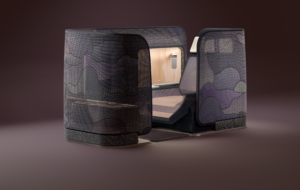

words Kieran Long
4330 technicolour glass discs have been used to cloak the facade of the Galleria department store, which just reopened in Seoul, South Korea.
The store is in the popular retail neighbourhood of Apgujeong-dong in Seoul, and is the equivalent of London’s Selfridges, stocking high-profile fashion brands in a variety of concessions. The exterior of the building, though, had previously been a dull concrete box. Dutch architects UN Studio covered the facade with 850mm-wide glass discs backed with a “dichroic” adhesive film developed by the architect in collaboration with tape-maker 3M. The material, which UN Studio recently used on the facade of an office building in the Netherlands (icon 017), changes colour as light hits it at different angles.
In the daytime, the facade’s colour depends on the direction of the sun. At night, it is lit by computer-controlled luminaires developed by UN Studio and Arup Lighting, which are programmed to create patterns and colours related to weather conditions. The facade is transformed into a pixel screen that the shop can use for advertising or just atmospheric projections. With the potential to generate over 16 million colours, it is like a cinemascope version of Future Systems’ disc-covered Selfridges in Birmingham.
The interior of the building has also been completely reworked: the spaces between the concessions have been reconceived as “catwalks” with illuminated ceilings “to make the visitor, like a model, the focus of the fashion world.”


















